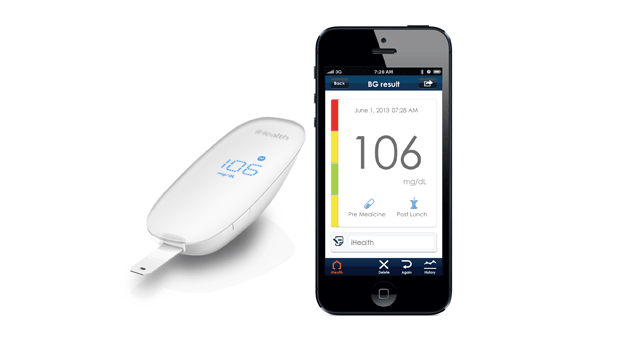The T1 Tech/Treatment Roundup: May 2014

Here’s the latest news on some of the gear and treatments that might make life easier for people with T1:
Pasta Lovers, Rejoice!
 The smart-looking little Dario glucometer is continuing its roll-out into the European marketplace by announcing it has received approval for reimbursement from Italian health insurance companies. The device is aiming to be the Swiss Army Knife of glucometers, with a glucose meter, disposable test strip cartridge, and a lance packed into a tiny device that plugs into a smartphone. It also has proprietary software that allows you to punch in your food intake and activity level to estimate your insulin needs. But perhaps most importantly to fashion-conscious Italians, it’s tiny and well-designed, so it can fit right in a posh pocket for the young person with diabetes on the back of a Vespa.
The smart-looking little Dario glucometer is continuing its roll-out into the European marketplace by announcing it has received approval for reimbursement from Italian health insurance companies. The device is aiming to be the Swiss Army Knife of glucometers, with a glucose meter, disposable test strip cartridge, and a lance packed into a tiny device that plugs into a smartphone. It also has proprietary software that allows you to punch in your food intake and activity level to estimate your insulin needs. But perhaps most importantly to fashion-conscious Italians, it’s tiny and well-designed, so it can fit right in a posh pocket for the young person with diabetes on the back of a Vespa.
T1 Tech-Savvy Teens
The UK chapter of the Juvenile Diabetes Research Foundation (JDRF) sent teens home with artificial pancreas-like systems to operate on their own for 3 weeks without researcher supervision, and the results were promising. As detailed in the journal Diabetes Care, the 16 pump-using teens were able to easily use the experimental device to achieve better blood glucose control and use less insulin. The experimental systems connected continuous glucose monitoring and automatic pump shut-off to prevent nighttime lows.
A Generic Revolt
According to Chain Drug Review, UniStrip is launching its line of generic blood glucose test strips to be used with OneTouch Ultra meters. Recently cleared by the FDA, these strips may sell for as low as $15 per 50 count. And yes, there is a publication called Chain Drug Review.
A Bullseye for Less Bolus?
 A drug designed to lower the amount of insulin people with T1 must take is making headway in clinical trials, according to a Reuters report. Lexicon Pharmaceuticals announced that trial participants using its experimental drug, LX4211, were able to lower the amount of insulin they took by 32% in a mid-stage trial. Analysts believe that the test results will be an investment lifeline for Lexicon, which recently has had to lay off workers. It might also help the company argue to the FDA that the drug is ready to roll for people with T1, instead of having to delay and do more trials to get clearance for the T2 crowd.
A drug designed to lower the amount of insulin people with T1 must take is making headway in clinical trials, according to a Reuters report. Lexicon Pharmaceuticals announced that trial participants using its experimental drug, LX4211, were able to lower the amount of insulin they took by 32% in a mid-stage trial. Analysts believe that the test results will be an investment lifeline for Lexicon, which recently has had to lay off workers. It might also help the company argue to the FDA that the drug is ready to roll for people with T1, instead of having to delay and do more trials to get clearance for the T2 crowd.
LX4211 totally sounds like the name Lex Luthor would give to a synthetic form of Kryptonite, though.
Your Annual CGM Change
How would you like to change your continuous glucose monitoring (CGM) site as often as you change your calendar? GlySens Incorporated is testing a subcutaneous CGM that could stay in place for a year at a time. About the size of a milk bottle cap, the device would be implanted under the skin using local anesthesia and then left there to do its job year-round, according to MedCity News. GlySens researchers have tested a prototype of this CGM on 6 human test subjects with good results. They hope to finish a larger trial in 2016, and go for FDA approval shortly thereafter.
Serve at Room Temperature
 Xeris Pharmaceuticals has announced it is starting Phase II human trials of room-temperature soluble glucagon. Researchers are specifically seeing how well their liquid glucagon formulation will work with an OmniPod pump. Glucagon right now only stays stable in powder form at room temperature, but Xeris is trying to keep it stable as a liquid so it can be used in pumps, pens, and auto-injectors. More importantly, room-temperature liquid glucagon is considered the vital missing ingredient for any truly closed-loop artificial pancreas system, so if Xeris perfects it, it will be given the keys to the diabetes kingdom.
Xeris Pharmaceuticals has announced it is starting Phase II human trials of room-temperature soluble glucagon. Researchers are specifically seeing how well their liquid glucagon formulation will work with an OmniPod pump. Glucagon right now only stays stable in powder form at room temperature, but Xeris is trying to keep it stable as a liquid so it can be used in pumps, pens, and auto-injectors. More importantly, room-temperature liquid glucagon is considered the vital missing ingredient for any truly closed-loop artificial pancreas system, so if Xeris perfects it, it will be given the keys to the diabetes kingdom.
Do you have a news tip or press release on new diabetes gear or treatments? Send it to Insulin Nation’s editor, Craig Idlebrook, at cidlebrook@epscomm.com.
Thanks for reading this Insulin Nation article. Want more Type 1 news? Subscribe here.
Have Type 2 diabetes or know someone who does? Try Type 2 Nation, our sister publication.







